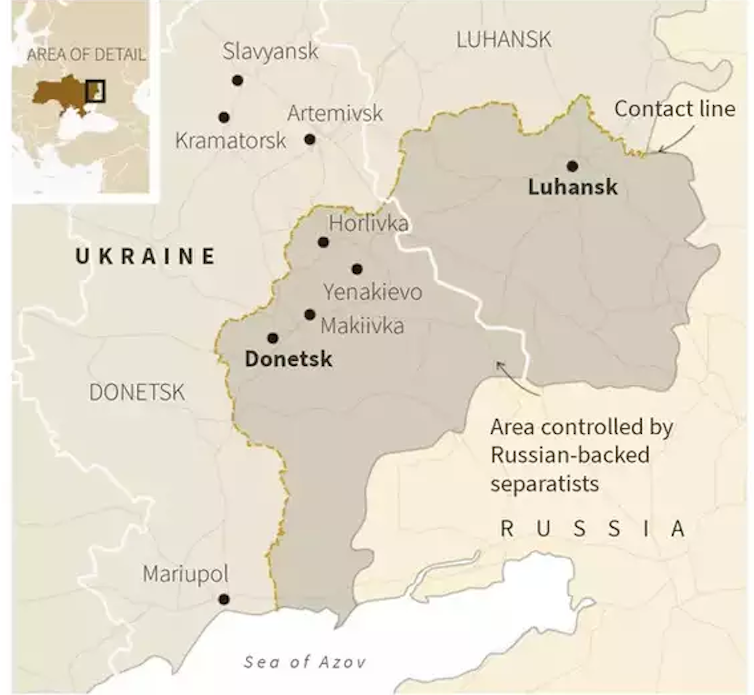Ukraine war: casualty counts from either side can be potent weapons and shouldn't always be believed
The war in Ukraine is shaping up to be one of the bloodiest of the 21st century, with both sides reported to be losing hundreds of soldiers each day as the conflict moves towards its first anniversary. But quite how many people are dying in this bitter struggle depends on who is doing the reporting.
Norway’s defence chief, General Eirik Kristoffersen, claimed recently that Russia has suffered 180,000 casualties to Ukraine’s 100,000, not counting 30,000 Ukrainian civilian casualties. The chairman of the US joint chiefs of staff, General Mark Milley, claimed that Russian casualties are “significantly well over 100,000 now”. US intelligence has reportedly suggested this figure is around 188,000.
But truth is said to be the first casualty of war and it is certainly possible that Kristoffersen and Milley are downplaying the number of Ukrainian casualties while overestimating Russia’s.
US-based military historian Christopher Lawrence believes that we tend “to take government claims of other people’s losses at face value”. He was referring to the Ukrainian claim last August that 121,480 Russian soldiers had been killed, against their own reported death toll of 9,000.
Russia has only provided two casualty reports. The most recent was on September 21 2022, when defence minister Sergei Shoigu said that 5,937 Russian troops had been killed. Mediazona, an independent Russian publication which is working with the BBC News Russian service to monitor the death toll, puts the figure at 12,538 deaths. So the numbers vary wildly from source to source.
Casualty reporting is a powerful tool of war propaganda, seen most starkly in the tit-for-tat accounts of two incidents around the new year. Ukraine claimed that its rocket attack on a Russian army barracks in Makiivka near Donetsk in the east of Ukraine on New Year’s Eve killed 400 Russian soldiers.
Russia countered that the attack, while deadly, had killed only about 60 troops (although prominent pro-Moscow blogger and former military leader Igor Girkin reportedly claimed the death toll was in the hundreds).
Meanwhile Russia claimed its revenge airstrike on Kramatorsk in the northern part of the Donetsk region killed 600 Ukrainian troops, a figure swiftly denied by Kyiv, which called the Russian claim “propaganda”. Ukraine’s assessment was verified by several news teams which did not find the extensive damage such an airstrike would inevitably cause.
Even those not directly involved in the conflict calibrate numbers to show those they don’t support in a bad light. The EU Commission president estimated that over 20,000 civilians have died in Ukraine to date – although a spokesperson later removed the estimate which she said included both dead and injured and “was meant to show Russia‘s brutality”.
Information warfare: soft war
Alongside combat and air strikes, contemporary conflicts increasingly involve the use of “soft war” tactics, such as economic sanctions and propaganda. Winning wars is not only about defeating the enemy on the battlefield, but also about influencing public opinion, domestic and international.
What has become known as “information operations” can deliver a decisive advantage to a warring state away from the battlefield. We’ve all heard of “psychological operations” – better known by their acronym Psyops – which aim to put an adversary off balance or influence foreign audiences and their governments to provide support.
Reports of decisive victories or unspeakable atrocities are important in the battle for hearts and minds. Casualty figures are also part of that battle.
Civilian combatants
Another factor which complicates assessments of the human cost of this war is the way both sides have pressed civilians into military service. Russia drafted 300,000 reservists and conscripts late last year, many of whom are already in the field, some of them in the front line to protect more experienced troops in the rear.
Ukrainian intelligence officials are warning that the Kremlin plans a new conscription wave for up to 500,000 men to fight in Ukraine in 2023.
Meanwhile, in July 2022 Ukraine introduced a system of permits prohibiting men eligible for conscription from leaving their region, to help the armed forces to locate potential conscripts. Since Zelensky declared martial law on February 24 2022, Ukrainian men between the ages of 18 and 60 became eligible for military service.
Ukraine’s authorities said conscription would occur in waves, starting with those with previous military experience, and would reflect the army’s needs. This is in addition to about 100,000 Ukraininan civilians who enlisted in the territorial defence force (military reserves) in the immediate aftermath of the invasion.
Under international law, civilians who become combatants, either through conscription or through enlisting, also become legitimate targets.
Body counts are often seen as a proxy for how a war is going. But it’s not as simple as that and these figures don’t always give an accurate indication of the real situation on the battlefield – materially or morally. In war, the concern is the amount of force necessary to achieve military objectives versus ethical considerations, especially when civilians-as-combatants become legitimate targets.
Whoever “wins” this war will achieve a pyrrhic victory (a win at excessively great cost). As in all wars, the “glorious dead” will be exploited for advantage by both sides. But that will only make us, once again, lose sight of the real, flesh-and-blood human losses and the grieving loved ones they leave behind.
This article is republished from The Conversation under a Creative Commons license. Read the original article.

Lily Hamourtziadou does not work for, consult, own shares in or receive funding from any company or organisation that would benefit from this article, and has disclosed no relevant affiliations beyond their academic appointment.

 Yahoo News
Yahoo News 

